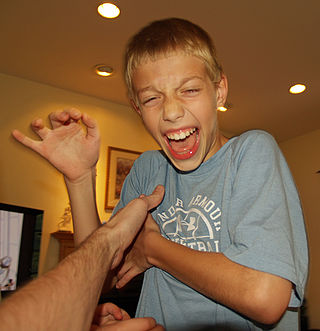Proxemics is the study of human use of space and the effects that population density has on behavior, communication, and social interaction. Proxemics is one among several subcategories in the study of nonverbal communication, including haptics (touch), kinesics, vocalics (paralanguage), and chronemics.

Body language is a type of nonverbal communication in which physical behaviors, as opposed to words, are used to express or convey information. Such behavior includes facial expressions, body posture, gestures, eye movement, touch and the use of space. Although body language is an important part of communication, most of it happens without conscious awareness. In social communication, body language often complements verbal communication.

Nonverbal communication is the transmission of messages or signals through a nonverbal platform such as eye contact (oculesics), body language (kinesics), social distance (proxemics), touch (haptics), voice (paralanguage), physical environments/appearance, and use of objects. When communicating, we utilize nonverbal channels as means to convey different messages or signals, whereas others can interpret these message. The study of nonverbal communication started in 1872 with the publication of The Expression of the Emotions in Man and Animals by Charles Darwin. Darwin began to study nonverbal communication as he noticed the interactions between animals such as lions, tigers, dogs etc. and realized they also communicated by gestures and expressions. For the first time, nonverbal communication was studied and its relevance questioned. Today, scholars argue that nonverbal communication can convey more meaning than verbal communication.
Intercultural communication is a discipline that studies communication across different cultures and social groups, or how culture affects communication. It describes the wide range of communication processes and problems that naturally appear within an organization or social context made up of individuals from different religious, social, ethnic, and educational backgrounds. In this sense, it seeks to understand how people from different countries and cultures act, communicate, and perceive the world around them. Intercultural communication focuses on the recognition and respect of those with cultural differences. The goal is mutual adaptation between two or more distinct cultures which leads to biculturalism/multiculturalism rather than complete assimilation. It promotes the development of cultural sensitivity and allows for empathic understanding across different cultures.

Haptic communication is nonverbal communication and interaction via the sense of touch. Touch can come in many different forms, some can promote physical and psychological well-being. A warm, loving touch can lead to positive outcomes while a violent touch can ultimately lead to a negative outcome. The sense of touch allows one to experience different sensations such as pleasure, pain, heat, or cold. One of the most significant aspects of touch is the ability to convey and enhance physical intimacy. The sense of touch is the fundamental component of haptic communication for interpersonal relationships. Touch can be categorized in many terms such as positive, playful, control, ritualistic, task-related or unintentional. It can be both sexual, and platonic. Striking, pushing, pulling, pinching, kicking, strangling and hand-to-hand fighting are forms of touch in the context of physical abuse.
Expectancy violations theory (EVT) is a theory of communication that analyzes how individuals respond to unanticipated violations of social norms and expectations. The theory was proposed by Judee K. Burgoon in the late 1970s and continued through the 1980s and 1990s as "nonverbal expectancy violations theory", based on Burgoon's research studying proxemics. Burgoon's work initially analyzed individuals' allowances and expectations of personal distance and how responses to personal distance violations were influenced by the level of liking and relationship to the violators. The theory was later changed to its current name when other researchers began to focus on violations of social behavior expectations beyond nonverbal communication.
The uncertainty reduction theory, also known as initial interaction theory, developed in 1975 by Charles Berger and Richard Calabrese, is a communication theory from the post-positivist tradition. It is one of the few communication theories that specifically looks into the initial interaction between people prior to the actual communication process. Uncertainty reduction theory originators' main goal when constructing it was to explain how communication is used to reduce uncertainty between strangers during a first interaction. Uncertainty reduction theory claims that everyone activates two processes in order to reduce uncertainty. The first being a proactive process, which focuses on what someone might do. The second being a retroactive process, which focuses on how people understand what another does or says. This theory's main claim is that people must receive information about another party in order to reduce their uncertainty and, that people want to do so. While uncertainty reduction theory claims that communication will lead to reduced uncertainty, it is important to note that this is not always the case. Dr. Dale E. Brashers of the University of Illinois argues that in some scenarios, more communication may lead to greater uncertainty.

Mirroring is the behavior in which one person subconsciously imitates the gesture, speech pattern, or attitude of another. Mirroring often occurs in social situations, particularly in the company of close friends or family, often going unnoticed by both parties. The concept often affects other individuals' notions about the individual that is exhibiting mirroring behaviors, which can lead to the individual building rapport with others.

Social information processing theory, also known as SIP, is a psychological and sociological theory originally developed by Salancik and Pfeffer in 1978. This theory explores how individuals make decisions and form attitudes in a social context, often focusing on the workplace. It suggests that people rely heavily on the social information available to them in their environments, including input from colleagues and peers, to shape their attitudes, behaviors, and perceptions.
The hyperpersonal model is a model of interpersonal communication that suggests computer-mediated communication (CMC) can become hyperpersonal because it "exceeds [face-to-face] interaction", thus affording message senders a host of communicative advantages over traditional face-to-face (FtF) interaction. The hyperpersonal model demonstrates how individuals communicate uniquely, while representing themselves to others, how others interpret them, and how the interactions create a reciprocal spiral of FtF communication. Compared to ordinary FtF situations, a hyperpersonal message sender has a greater ability to strategically develop and edit self-presentation, enabling a selective and optimized presentation of one's self to others.
Thin-slicing is a term used in psychology and philosophy to describe the ability to find patterns in events based only on "thin slices", or narrow windows, of experience. The term refers to the process of making very quick inferences about the state, characteristics or details of an individual or situation with minimal amounts of information. Research has found that brief judgments based on thin-slicing are similar to those judgments based on much more information. Judgments based on thin-slicing can be as accurate, or even more so, than judgments based on much more information.
Social presence theory explores how the "sense of being with another" is influenced by digital interfaces in human-computer interactions. Developed from the foundations of interpersonal communication and symbolic interactionism, social presence theory was first formally introduced by John Short, Ederyn Williams, and Bruce Christie in The Social Psychology of Telecommunications. Research on social presence theory has recently developed to examine the efficacy of telecommunications media, including SNS communications. The theory notes that computer-based communication is lower in social presence than face-to-face communication, but different computer-based communications can affect the levels of social presence between communicators and receivers.
Cognitive valence theory (CVT) is a theoretical framework that describes and explains the process of intimacy exchange within a dyad relationship. Peter A. Andersen, PhD created the cognitive valence theory to answer questions regarding intimacy relationships among colleagues, close friends and intimate friends, married couples and family members. Intimacy or immediacy behavior is that behavior that provides closeness or distance within a dyad relationship. Closeness projects a positive feeling in a relationship, and distance projects a negative feeling within a relationship. Intimacy or immediacy behavior can be negatively valenced or positively valenced. Valence, associated with physics, is used here to describe the degree of negativity or positivity in expected information. If your partner perceives your actions as negative, then the interaction may repel your partner away from you. If your partner perceives your actions as positive, then the interaction may be accepted and may encourage closeness. Affection and intimacy promotes positive valence in a relationship. CVT uses non-verbal and verbal communications criteria to analyze behavioral situations.

Interpersonal communication is an exchange of information between two or more people. It is also an area of research that seeks to understand how humans use verbal and nonverbal cues to accomplish several personal and relational goals. Communication includes utilizing communication skills within one's surroundings, including physical and psychological spaces. It is essential to see the visual/nonverbal and verbal cues regarding the physical spaces. In the psychological spaces, self-awareness and awareness of the emotions, cultures, and things that are not seen are also significant when communicating.

In humans, posture can provide a significant amount of important information through nonverbal communication. Psychological studies have also demonstrated the effects of body posture on emotions. This research can be traced back to Charles Darwin's studies of emotion and movement in humans and animals. Currently, many studies have shown that certain patterns of body movements are indicative of specific emotions. Researchers studied sign language and found that even non-sign language users can determine emotions from only hand movements. Another example is the fact that anger is characterized by forward whole body movement. The theories that guide research in this field are the self-validation or perception theory and the embodied emotion theory.
Social cues are verbal or non-verbal signals expressed through the face, body, voice, motion and guide conversations as well as other social interactions by influencing our impressions of and responses to others. These percepts are important communicative tools as they convey important social and contextual information and therefore facilitate social understanding.
Affiliative conflict theory (ACT) is a social psychological approach that encompasses interpersonal communication and has a background in nonverbal communication. This theory postulates that "people have competing needs or desires for intimacy and autonomy". In any relationship, people will negotiate and try to rationalize why they are acting the way they are in order to maintain a comfortable level of intimacy.
Social Mirror Theory (SMT) states that people are not capable of self-reflection without taking into consideration a peer's interpretation of the experience. In other words, people define and resolve their internal musings through other's viewpoint. SMT's background is derived from the 1800s from concepts related to the study of public opinion and social interaction by Wilhelm Dilthey, the German philosopher and sociologist.
Nonverbal influence is the act of affecting or inspiring change in others' behaviors and attitudes by way of tone of voice or body language and other cues like facial expression. This act of getting others to embrace or resist new attitudes can be achieved with or without the use of spoken language. It is a subtopic of nonverbal communication. Many individuals instinctively associate persuasion with verbal messages. Nonverbal influence emphasizes the persuasive power and influence of nonverbal communication. Nonverbal influence includes appeals to attraction, similarity and intimacy.
In psychology, interpersonal accuracy (IPA) refers to an individual's ability to make correct inferences about others' internal states, traits, or other personal attributes. For example, a person who is able to correctly recognize emotions, motivation, or thoughts in others demonstrates interpersonal accuracy. IPA is an important skill in everyday life and is related to many positive social interaction outcomes.







